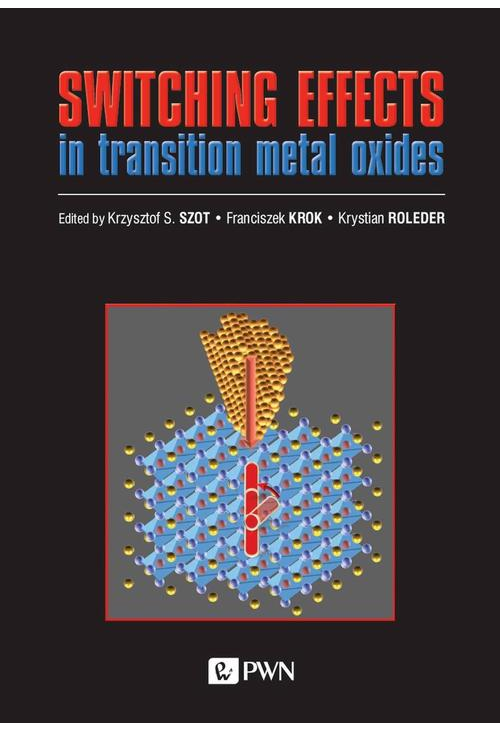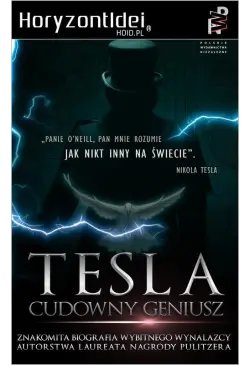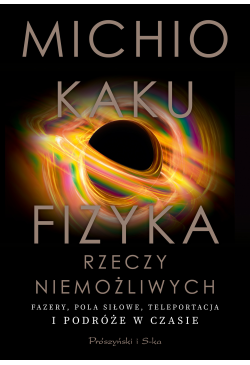
- -11%
ebook Switching effects in transition metal oxides
Odkryj rewolucyjny wgląd w świat przełączania efektów w tlenkach metali przejściowych dzięki najnowszemu wydaniu książki autorstwa Franciszka Kroka, Krystiana Roledera i Krzysztofa S. Szota. Opublikowana przez renomowane Wydawnictwo Naukowe PWN w 2021 roku, ta publikacja stanowi niezwykle cenną pozycję zarówno dla naukowców, jak i entuzjastów literatury naukowej.
Książka "Switching Effects" zapewnia głęboki wgląd w rosnące znaczenie tlenków metali przejściowych w różnych dziedzinach nauki i technologii, od nanoelektroniki po katalizę przemysłową. Autorzy nie tylko łączą zjawisko przełączania z wpływem makroskopowych bodźców na parametry porządku w ferroikach, ale także wyjaśniają, że przełączanie ma swoje źródło na nanoskali i można je badać za pomocą czułych na powierzchnię metod, takich jak LCAFM, PFM czy KPFM.
Wyjątkowa pozycja wśród ebooków dostępnych online, "Switching Effects" to kompleksowe źródło wiedzy na temat mechanizmów przełączania rezystancyjnego od stanu półprzewodnikowego do metalicznego. Dla miłośników nauki i literatury pięknej, ten ebook to obowiązkowa lektura, która z pewnością znajdzie się w gronie najlepszych publikacji cyfrowych tego roku.
Pobierz teraz swój egzemplarz ebooka "Switching Effects" i dołącz do grona czytelników, którzy odkrywają sekrety przełączania w tlenkach metali przejściowych. Zanurz się w świecie fascynującej nauki i technologii - ebooki dostępne są w formatach PDF, gotowe do natychmiastowego pobrania ze sklepu z e-bookami. Czytaj na dowolnym urządzeniu i ciesz się literaturą piękną nauki!
Spis treści ebooka Switching effects
Introduction 111. An Introduction to the Crystal Structures of Oxide Perovskites 13
1.1. Atomic Displacements 15
1.2. Octahedral Tilting 23
1.3. Distortion Modes 25
References 28
2. Growth of ABO3 and BO2 Crystals 30
2.1. Theory of Crystal Growth 30
2.1.1. Equilibrium Conditions 30
2.2. Phase Diagrams of Model Oxides. Major Challenges in Crystal Growth of Stoichiometric Oxide Crystals 33
2.2.1. Gibbs Phase Rule 33
2.2.2. Phase Diagrams 34
2.2.3. Nonstoichiometric Oxides 34
2.3. Techniques of Growth of Selected Binary and Ternary Oxide Crystals 35
2.4. Typical Methods for Evaluation of Quality of Oxide Crystals 40
2.4.1. Stoichiometric TiO2 41
2.4.2. Perovskite Structure 41
References 46
3. Defect Chemistry in Binary and Ternary Metal Oxides 51
3.1. Introduction 51
3.2. Imperfect Crystals 52
3.3. Quasi-chemical Defect Reactions 53
3.4. Types of Point Defects 54
3.5. Thermodynamic Approach 54
3.6. Nonstoichiometry 57
3.7. Aggregations of Point Defects and Extended Defects 58
3.8. Ideal Point Defect Model 61
3.8.1. Case of Ni1–yO 61
3.8.2. Case of BaTiO3–y 64
3.8.3. Case of Zirconia-based Materials 67
3.8.4. Defect Structure of YSZ 72
3.9. Debye-Hückel Defect Model 73
3.9.1. Co1–yO Case 73
3.10. Cluster Model 77
3.10.1. Defect Clustering in the Wustite Phase 77
3.11. Crystallographic Shearing 80
3.12. Defect Structure of Titanium Dioxide 81
3.12.1. Extended Defects in TiO2 85
3.13. Hydrogen Defects 86
Acknowledgements 87
References 87
4. Self-Polarization of Ferroelectric Thin Films and Its Influence on the Film Properties 92
4.1. Introduction 93
4.2. Free Energy Functional 94
4.3. Renormalized Free Energy and Properties for One Component Polarization P = PZ 96
4.4. The Influence of Built-in Electric Field on the Properties of Ferroelectric Thin Films for the Case P = PZ 99
4.5. Phase Diagrams with Electret State and Properties for the Case of Three Polarization Components 103
4.6. Comparison with Experiment and Summary of Sec. 5 Results 114
Conclusion 117
References 118
5. Lattice Dynamics of Perovskite Oxides 120
5.1. Introduction 120
5.2. Early Attempts to Model Ferroelectric Perovskites 121
5.3. Polarizability Effects in Perovskites 124
5.4. The Polarizability Model for Perovskites 126
5.5. Applications of the Model 131
5.6. Precursor Effects to the Phase Transitions 137
Conclusions 146
References 147
6. Metrology and Measurement Techniques 151
6.1. Electrical Properties of Nanoscale Solids 151
6.1.1. Measurement of Electrical and Magnetic Material Properties 152
6.1.2. The Piezoelectric Effect 163
6.2. Design of Measurement Setups 166
6.2.1. General Considerations 166
6.2.2. Active Amplifier Circuits 169
6.2.3. Measurement Methods for Ferroelectric Properties 172
6.2.4. Laser Interferometers 183
References 188
7. Multiferroics 190
7.1. Abstract 190
7.2. Introduction 190
7.3. A Brief History of Magnetoelectrics and Multiferroics 191
7.4. Symmetries and Orderings in Multiferroics 192
7.5. Theory of Magnetoelectric Coupling in Multiferroics 193
7.6. Magnetoelectric Multiferroics 200
Acknowledgements 218
References 218
8. Electronic Correlations and Metal-Insulator Transitions 223
8.1. Introduction: The Meaning of Localization – Delocalization
Transitions in Solids with Examples 223
8.1.1. Crystallization of Liquid 3He as Mott-Hubbard Transition 223
8.1.2. Localization-Delocalization Transition of Ultracold Atoms 225
8.1.3. Metal-Insulator Transition in Doped V2O3 226
8.2. Elementary Approach to the Metal-Insulator (Mott-Hubbard) Transitions 228
8.2.1. Normal metal as a Landau Fermi liquid: basic characteristics 228
8.2.2. Mott-Wigner Criterion of Localization 230
8.2.3. 8.2.3 Localization on the Lattice: Hubbard Model 232
8.2.4. Quantitative Discussion of the Metal-Insulator Transition 233
8.2.5. Quasiparticle Representation of Correlated-Electron System and the Phase Diagram 236
8.2.6. Mott-Hubbard Localization in Correlated Nanoscopic Systems 241
8.3. Concluding Remarks 244
Acknowledgment 244
References 244
9. Nature of the Insulator-Metal Transition in Transition Metal Oxides Induced by Chemical Defects – Deviation from Stoichiometry and Electrochemical Alkaline Intercalation 245
9.1. Insulator-Metal Transition in Transition Metal Oxides Induced by Deviation from Stoichiometry 247
9.2. Insulator-Metal Transition in Transition Metal Oxides Induced by Electrochemical Alkaline Intercalation/Deintercalation 272
9.2.1. LixCoO2 276
9.2.2. NaxCoO2-y 285
Acknowledgements 295
References 296
10. Structural Transformation of the SrTiO3 Surface Region due to Electric Fields at Ambient Temperature 299
10.1. Modifications and Equilibrium of the SrTiO3 Structure 300
10.1.1. Compositional Changes: the Quasi-binary System SrO–TiO2 300
10.1.2. Stability of SrO(SrTiO3)n Ruddlesden-Popper Phases 303
10.1.3. A Look at Symmetry and Property Tensors 304
10.1.4. Chemical Modifications Beyond the Ternary Composition 306
10.2. Electric-field Induced Ionic Transport and Anisotropy in SrTiO3 307
10.2.1. Electroformation 308
10.2.2. Redistribution of Ionic Species 310
10.3. Evidence for Structural Transformations and Related Models 312
10.3.1. Structural Transitions due to Application of an Electric Field 312
10.3.2. The Occurence of Ruddlesden-Popper Phases 313
10.3.3. The Migration-Induced Field-Stabilized Polar (MFP) Phase 314
10.4. Modification of SrTiO3 Properties and Related Applications 317
10.4.1. Oxygen Vacancies and Conductivity 318
10.4.2. Mechanical Properties 319
10.4.3. Magnetism 321
10.4.4. Pyroelectricity 321
10.4.5. Piezoelectricity 323
10.4.6. Resistive Switching 325
10.4.7. All-Solid-State All-in-One Battery 326
10.4.8. Further Applications 326
10.5. Conclusion 327
Acknowledgment 328
References 329
11. Chemical Transformation of SrTiO3 Surface Region Exposed to High Temperature and Other Factors 336
11.1. Introduction 336
11.2. Investigated Crystals 339
11.3. Possible Surface Reconstructions of STO 340
11.4. Methods of Surface Studies 341
11.5. Thermal Treatment 341
11.6. Surface Modification upon Vacuum and Exposure to X-Rays and Electron Beam 348
11.7. Ion Sputtering 351
11.8. Deposition of Metals 354
11.9. Mechanical Stress and Defects 355
Summary 356
References 357
12. Chemical Transformation of TiO2 Surface Region Exposed to High Temperature and Different Chemical Activity of Oxygen 359
Acknowledgements 375
References 375
13. From Electroformation to Resistive Switching in Single Crystals of Strontium Titanate: How SrTiO3 Can Be Transformed into a Metallic State Using Electrical Stimuli 378
13.1. Introduction 378
13.2. Resistive Switching – General Information 381
13.3. Some Theoretical Considerations 386
13.3.1. Methods for the Calculation of the Electronic Structure 388
13.3.2. Trends Observed from DFT Calculations 393
13.4. Electroforming of Non-conducting (Insulating) SrTiO3 Crystals 394
13.4.1. Electrical Characterization During Electroformation 394
13.4.2. Oxygen Evolution During Electroformation 399
13.4.3. Spatial Inhomogeneity of the Electroformation Process and Filamentary Structures 402
13.5. Model 410
References 417
14. Crystallographic Structure, Electronic Structure, and Chemical Composition on the Nanoscale: Important Role of the SPM, LEED, Photoemission Investigations for the Analysis of the Crystal Geometry, Electronic Structure and Diffusion Phenomena on the Surface of Model Oxides 420
Acknowledgements 437
References 437
15. Investigations of Local Thermal Properties by SThM Microscopy 439
15.1. Scanning Thermal Microscopy: Principle, Equipment, Operation Modes 440
15.2. Thermal Imaging: Temperature and Conductivity Contrast Measurements 445
15.3. Quantitative Thermal Measurements with SThM Equipment – Potentialities and Limitations 448
15.4. Methods for Improvements of Sensitivity and Stability of Thermal Measurements Using Batch Fabricated Thermal Probes 453
15.5. Determination of the Thermal Conductivity of Submicron Layers on Thick Substrates 458
15.6. Application of Qualitative and Quantitative SThM Measurements in Investigation of Perovskites (Thin Films, Bicrystals) 460
Acknowledgements 462
References 463
16. Studying the Local Redox Processes on Transition Metal Oxides Surfaces Using Kelvin Probe Force Microscopy 466
16.1. Introduction 466
16.2. Principles of Kelvin Probe Force Microscopy 468
16.2.1. Basics of KPFM Operation 468
16.2.2. Forces in Atomic Force Microscopy 469
16.2.3. Technical Realization of KPFM 472
16.2.4. Limits of Resolutions in KPFM 474
16.3. Local Surface Potential of Oxide Metal Surfaces upon Reduction and Oxidation Processes 478
16.3.1. Titanium Dioxide TiO2(110) Surface 478
16.3.2. Strontium Titanate SrTiO3(100) Surface 484
16.4. Summary 491
Acknowledgements 492
References 492
Szczegóły ebooka Switching effects
- Wydawca:
- Wydawnictwo Naukowe PWN
- Rok wydania:
- 2021
- Typ publikacji:
- Ebook
- Język:
- polski
- Format:
- epub mobi
- Liczba stron:
- 500
- Miejsce wydania:
- Warszawa
- ISBN dla wersji papierowej:
- 9788301213169
Recenzje ebooka Switching effects
-
Reviews (0)

Na jakich urządzeniach mogę czytać ebooki?
- -11%














@CUSTOMER_NAME@
@COMMENT_TITLE@
@COMMENT_COMMENT@